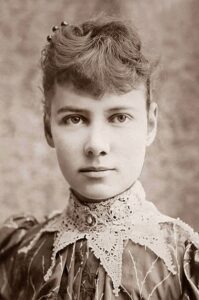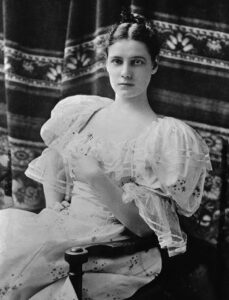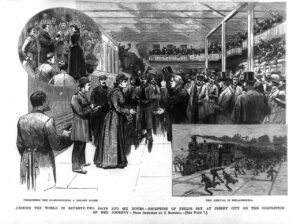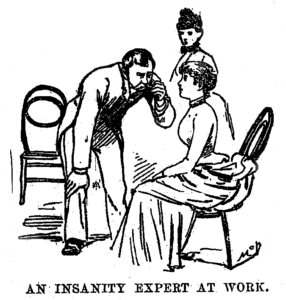
 When Elizabeth Jane Cochrane was born on May 5, 1864, there were things that women couldn’t do. It was a man’s world, after all. Not much had changed by the time she was eighteen years old. She was living in Pittsburgh when the local newspaper published an article titled “What Girls are Good For” and according to the article, the answer was having babies and keeping house. These days such an article would have brought immediate outrage, protests, and the author practically strung up. Due to the times, the author would have gotten away with it, but in this case, Elizabeth Cochrane saw it and was very displeased. She was displeased enough, in fact, that she wrote an anonymous rebuttal.
When Elizabeth Jane Cochrane was born on May 5, 1864, there were things that women couldn’t do. It was a man’s world, after all. Not much had changed by the time she was eighteen years old. She was living in Pittsburgh when the local newspaper published an article titled “What Girls are Good For” and according to the article, the answer was having babies and keeping house. These days such an article would have brought immediate outrage, protests, and the author practically strung up. Due to the times, the author would have gotten away with it, but in this case, Elizabeth Cochrane saw it and was very displeased. She was displeased enough, in fact, that she wrote an anonymous rebuttal.
Strangely, the paper’s editor was quite impressed with her rebuttal. He immediately ran an ad in his paper asking the writer to identify herself. Boldly, Elizabeth contacted him, and he hired her on the spot. I’m quite sure that she was not expecting that at all. Still, in this “man’s world” she could not really let anyone know that she was the writer…and maybe that wasn’t exactly a bad thing. Going up against the men is such an argument using her own name might bring some unwanted attention. After all, things were in the very early stages of women’s rights. At that time, most women were still housewives…or schoolteachers, librarians, seamstresses, and such, if they had to work outside the home. So, it was customary at that time for female reporters to use pen names. To top it off, she wasn’t even allowed to pick out her own pen name. The editor gave her one that he took from a Stephen Foster song…Nellie Bly, and it would actually make her famous…as Nellie Bly anyway.
Bly’s passion was investigative reporting, but once again, she found herself stumbling over the whole “man’s world” concept. While she was given work, the paper usually assigned her to more “feminine” subjects…things like theater and fashion. Still, they couldn’t keep her under their thumb very well. After writing a controversial series of articles exposing the working conditions of female factory workers, and after again being relegated to reporting on society functions and women’s hobbies…at age 21 Bly left for Mexico on a dangerous and unprecedented (for a woman) assignment to report of the conditions of the working-class people there. It didn’t take long for her reporting to get her in trouble with the local authorities. Wisely, Bly fled Mexico, but didn’t give up on her story. She later published her dispatches into a popular book.
By the time Bly was 23, she had established a reputation for being a daring and provocative reporter. This drew  the attention of Joseph Pulitzer’s New York World, where she was hired to basically work under cover. It was the assignment that made her famous. In order to investigate the conditions inside New York’s “Women’s Lunatic Asylum,” Bly took on a fake identity (not really a new concept for someone using a pen name to write), checked into a women’s boarding house, and faked insanity. Bly was so convincing that she soon found herself committed to the asylum. I would personally find that a scary situation, but Bly was dedicated. The report she published of her ten days there was a sensation and led to important reforms in the treatment of the mentally ill.
the attention of Joseph Pulitzer’s New York World, where she was hired to basically work under cover. It was the assignment that made her famous. In order to investigate the conditions inside New York’s “Women’s Lunatic Asylum,” Bly took on a fake identity (not really a new concept for someone using a pen name to write), checked into a women’s boarding house, and faked insanity. Bly was so convincing that she soon found herself committed to the asylum. I would personally find that a scary situation, but Bly was dedicated. The report she published of her ten days there was a sensation and led to important reforms in the treatment of the mentally ill.
Nellie Bly was a woman to be remembered. When she was 24, she undertook her most sensational assignment yet: a solo trip around the world inspired by Jules Verne’s Around the World in 80 Days. Ready to go at the drop of a hat, Bly was given only two days’ notice, before she set out on November 14, 1889. She packed a travel bag with her toiletries and a change of underwear, tied her purse around her neck, and she was off. Pulitzer’s competitor, the New York Cosmopolitan, took that as a challenge and immediately sent out one of its reporters, Elizabeth Bisland, to race Bly, but traveling in the opposite direction. As Pulitzer had hoped, the stunt was a publicity bonanza. Readers gobbled up the regular reports on Bly’s journey and the paper sponsoring a contest for readers to guess the exact time of Bly’s return. The winning guess would be awarded an expense-paid trip to Europe.
Bly made her triumphant return just seventy-two days later, four and half days ahead of Bisland. She had successfully circumnavigated the globe, while traveling alone almost the entire time. It was a world record…the fastest any human had ever made the journey. Suddenly, Nellie Bly was an international celebrity. I still wonder if there was some regret that she was still using the pen name, or maybe it gave her a degree of anonymity, until people recognized her, that is.
After leading an almost insanely adventurous life, Bly decided to retire…so to speak. When she was 31 years old, Bly married industrialist Robert Seaman, a 73-year-old millionaire. With her marriage, she left behind her journalism career and her pen name and became Elizabeth Cochrane Seaman. She helped run the Seaman family business. While working as an industrialist, she patented two inventions, but she knew that business was not really her forte, and sadly, under her leadership the company went bankrupt. I’m sure that with all her life 
 successes, that was a devastating failure for her. With the outbreak of World War I broke out, she returned to journalism, becoming one of the first women reporters to work in an active war zone. I have no doubt that Nellie Bly (Elizabeth Cochrane Seaman) could have done so many more remarkable things in her life, but sadly, her remarkable life ended on January 27, 1922, when she died of pneumonia in New York at age 57.
successes, that was a devastating failure for her. With the outbreak of World War I broke out, she returned to journalism, becoming one of the first women reporters to work in an active war zone. I have no doubt that Nellie Bly (Elizabeth Cochrane Seaman) could have done so many more remarkable things in her life, but sadly, her remarkable life ended on January 27, 1922, when she died of pneumonia in New York at age 57.


Leave a Reply